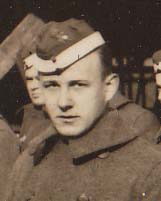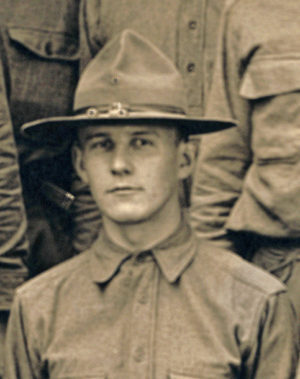(East Hampton, Connecticut, October 4, 1895 – Waterbury, Connecticut, October 9, 1976).1
Bevin was descended from a family that could trace its roots in Connecticut back to the Revolutionary War and beyond. His grandfather, Philo Bevin, was one of four brothers who founded Bevin Brothers Manufacturing Company, maker of bells (including Salvation Army bells and the bell rung to open the New York Stock Exchange).2
Bevin attended Princeton (class of 1917); he graduated from Princeton ground school August 25, 1917, as did his brother, Allen William Bevin, who went on to fly Capronis in Italy.3
Having, along with other members of his Princeton ground school class, signed up to go to Italy for advanced training, Bevin set sail September 18, 1917, from New York on the Carmania as one of the 150 men of the “Italian” or “Second Oxford Detachment.” After a stopover at Halifax to join a convoy for the Atlantic crossing, the Carmania had an uneventful voyage and docked at Liverpool on October 2, 1917. The men there learned that they were to proceed not to Italy, but to Oxford.

They attended ground school (again) at the School of Military Aeronautics at Oxford. Bevin was among those chosen by Elliott White Springs to go from Oxford to Stamford to begin flight training (rather than to machine gun school at Grantham).4 The group of twenty men left Oxford for No. 1 Training Depot Squadron at Stamford on November 5, 1917.4a By early March Bevin had completed enough flying to be recommended for a commission; Pershing’s cablegram forwarding the recommendation is dated March 13, 1918, and the confirming cable March 29, 1918.5 George Augustus Vaughn ran into Bevin in London on April 1 or 2, 1918, and went to dinner and a show with him: “He [Bevin] got his commission there in town that same day.”4b Soon thereafter he apparently reported to Amesbury, presumably to train at either the No. 1 School of Navigation and Bomb Dropping at Stonehenge or at No. 6 Training Depot Station at Boscombe Down.4c
A passing reference to Bevin in a letter written by Edward Russell Moore indicates that Bevin was training at Turnberry towards the end of May 1918; I have otherwise not been able to document Bevin’s activities after he went to No. 1 T.D.S. until July, when he, along with a number of other second Oxford detachment members, was at the 3rd Aviation Instruction Center at Issoudun, France.5a On August 21, 1918, he, along with fellow second Oxford detachment member Uel Thomas McCurry, joined the U.S. 8th Aero Squadron at Amanty; other men from the detachment—Edward Addison Griffiths, Anker Christian Jensen, Edward Russell Moore, John Howard Raftery, and Hilary Baker Rex—had arrived there in the preceding days.6 The 8th was an observation squadron flying (American) DH-4s; it had been at Amanty, about twenty-five miles south of St. Mihiel, since the last day of July. The squadron was now doing intensive training, including making flights over the lines. On August 31, 1918, they moved about nine miles north, to Ourches-sur-Meuse. Bevin was assigned as a pilot to B flight, accompanied by observer Clyde Evert Dike.7 The squadron flew reconnaissance missions in preparation for and during the Battle of St. Mihiel in mid-September. On the 12th and 13th planes of the 8th Aero “were in the air for thirty-six hours and thirty minutes . . . and twenty-four separate missions were accomplished.”8 At the end of September, the squadron moved a few miles east to Toul and flew extensive photographic missions as well as voluntary bombing missions.9 On October 23, 1918, the 8th Aero moved about ten miles northeast to Saizerais and was soon joined by the U.S. 354th Aero Squadron, new to the front. Bevin was among the fourteen pilots and observers who were transferred to the 354th on October 25, 1918 in order to provide the squadron some experienced men; reconnaissance flights were begun within days and continued until the armistice.10
On returning to the U.S., Bevin studied architecture, receiving a degree from the University of Pennsylvania in 1922 and going on to a distinguished career as an architect.11
Notes
(For complete bibliographic entries, please consult the list of works and web pages cited.)
1 For his date and place of birth, see Ancestry.com, U.S., World War I Draft Registration Cards, 1917-1918, record for Vaston Phils Bevin II [sic]. For his date and place of death, see Connecticut Department of Health, Connecticut Death Index, 1949-2012, record for Newto P Bevin [sic]. Bevin called himself “Bevin II” or “Jr.” to distinguish himself from an uncle of the same name. The photo of Bevin is a detail from a photo taken by Orren Jack Turner of the first class to graduate from the Princeton School of Military Aeronautics.
2 Bevin Bros. Manufacturing Company. On Bevin’s descent, see documents available at Ancestry.com, including the Sons of the American Revolution membership application made by his second cousin, Marshall Bevin.
3 The Princeton Bric-a-Brac 1917, p. 45; “Ground School Graduations [for August 25, 1917].”
4 Neely, Diary, entry for November 1, 1917; and “Princeton’s Last Varsity Football Team Now in Service,” col. 3.
4a Deetjen, diary entry for November 5, 1917.
4b Vaughn, War Flying in France, letters of April 3 and 14, 1918.
4c See Biddle, Special Orders No. 35.
5 See cablegrams 726-S and 1008-R.
5a See Moore’s letter of June 2, 1918, reproduced in “From Trench and Camp” (July 15, 1918), and Dwyer, “Memorandum No. 8 for Flying Officers,” p. 4.
6 “8th Aero Squadron,” pp. 140–41.
7 “8th Aero Squadron,” p. 134.
8 8th Aero Squadron,” p. 160. I have been unable to find operations reports that might provide details of individual flights.
9 “8th Aero Squadron,” p. 112.
10 “8th Aero Squadron,” pp. 112 and 144; “354th Aero Squadron (Observation),” pp. 145-46.
11 “Bevin, Newton Philo, Jr. (1895-1976), Architect.”

